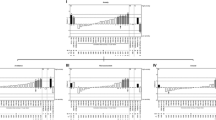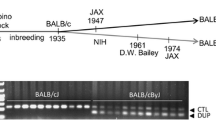Abstract
Congenic strains (CS) of mice were established to identify genomic regions which are associated with the male behavioral trait “isolation-induced aggression” (iia). For this purpose the trait was backcrossed for 10 generations onto the genetic background of a closely related, but nonaggressive, strain. Brother/sister matings were subsequently performed for 10 generations. Genomic screening for “iia-associated” markers was performed via multilocus DNA fingerprinting with a panel of oligonucleotide probes containing simple tandem repetitive motifs. Pools of DNAs from 10 mice each were composed from inbred generations to minimize residual genetic variability in the CS. The representation of iia-associated DNA fingerprint bands was additionally ascertained by investigating the individual mouse genomes constituting the pools. The CS system may allow rational approaches to the behavioral trait “aggression,” even under various experimental conditions of different environments.
Similar content being viewed by others
References
Bailey, D. W. (1978). Sources of subline divergence and their relative important of six major inbred strains of mice. In Morse, H. C., III (ed.),Origins of Inbred Mice, Academic Press, New York, pp. 197–215.
Bailey, D. W. (1981). Recombinant inbred strains and bilineal congenic strains. In Foster, H. L., and Small, J. D. (eds.),The Mouse in Biomedical Research, Academic Press, New York, pp. 223–239.
Berrettini, W. H., Ferraro, T. N., Alexander, R. C., Buchberg, A. M., and Vogel, W. H. (1994). Quantitative trait loci mapping of three loci controlling morphine preference using inbred mouse strains.Nature Genet. 7:54–58.
Bonhomme, F. (1986). Evolutionary relationships in the genus Mus.Curr. Topics Microbiol. Immunol. 127:19–34.
Brain, P. F., Benton, D., Childs, G., and Parmigiani, S. (1981). The effect of the type of opponent in tests of murine aggression.Behav. Process. 6:319–327.
Brain, P. F., Mainardi, D., and Parmigiani, S. (1989).House Mouse Aggression: A Model for Understanding the Evolution of Social Behaviour, Harwood Academic, London.
Carlier, M., Roubertoux, P. L., and Pastoret, C. (1991). The y chromosome effect on intermale aggression in mice depends on the maternal environment.Genetics 129:231–236.
Ciaranello, R. D., Lipsky, A., and Axelrod, J. (1974). Association between fighting behavior and catecholamine biosynthetic enzyme activity in two inbred mouse sublines.Proc. Natl. Acad. Sci. USA 71:3006–3008.
Demant, P., van Zutphen, L. F. M., Hart, A. A. M., and Moen, C. J. A. (1992). In Goldowitz, D., Wahlsten, D., and Wimer, R. E. (eds.),Techniques for the Genetic Analysis of Brain and Behavior: Focus on the Mouse, Elsevier, New York, pp. 147–161.
Dudek, B. C., and Underwood, K. A. (1993). Selective breeding, congenic strains, and other classical genetic-approaches to the analysis of alcohol-related polygenic pleiotropisms.Behav. Genet. 23:179–189.
Ebert, P. D. (1983) Selection for aggression in a natural population. In Simmel, E. C., Hahn, M. E., and Walters, J. K. (eds.),Aggressive Behavior: Genetic and Neural Approaches, Erlbaum, Hillsdale, NJ, pp. 103–127.
Eleftheriou, B. E., Bailey, D. W., and Denenberg, V. H. (1974). Genetic analysis of fighting behavior in mice.Physiol. Behav. 13:773–777.
Epplen, J. T. (1992). The methodology of multilocus fingerprinting using radioactive or nonradioactive oligonucleotide probes specific for simple repeat motifs.Adv. Electrophores. 5:59–112.
Epplen, J. T., Studer, R., and McLaren, A. (1988). Heterogeneity in theSxr (sex-reversal) locus of the mouse as revealed by synthetic GAT/CA probes.Genet. Res. 51:239–246.
Epplen, C., Melmer, G., Siedlaczck, I., Schwaiger, F.-W., Mäueler, W., and Epplen, J. T. (1993). On the essence of “meaningless” simple repetitive DNA in eukaryote genomes. In Pena, S. D. J., Chakraborty, R., Epplen, J. T., and Jeffreys, A. J. (eds.),DNA Fingerprinting: State of the Science, Birkhäuser, Basel, pp. 29–45.
Epplen, J. T., Buitkamp, J., Bocker, T., and Epplen, C. (1994). Indirect gene diagnoses for complex multifactorial diseases.Gene (in press).
Hahn, M. E., and Haber, S. B. (1982). The inheritance of agonistic behavior in male mice: A diallel analysis.Aggress. Behav. 5:217–231.
Hedrich, H. J. (1990).Genetic Monitoring of Inbred Strains of Rats, Gustav-Fischer Verlag, Stuttgart.
Hillel, J., Avner, R., Baxter-Jones, C., Dunnington, E. A., Cahaner, A., and Siegel, P. B. (1990). DNA fingerprints from blood mixes in chickens and in turkeys.Anim. Biotechnol. 1:201–204.
Kelly, R., Bulfield, G., Collick, A., Gibbs, M., and Jeffreys, A. J. (1989) Characterization of a highly unstable mouse minisatellite locus: Evidence for somatic mutation during early development.Genomics 5:844–856.
Kessler, S., Harmatz, P., and Gerling, S. A. (1975). The genetics of pheromonally mediated aggression in mice. I. Strain differences in the capacity of male urinary odors to elicit aggression.Behav. Genet. 5:233–238.
Maxson, S. C. (1992). Methodological issues in genetic analyses of an agonistic behavior (offense) in male mice. In Goldowitz, D., Wahlsten, D., and Wimer, R. E. (eds.),Techniques for the Genetic Analysis of Brain and Behavior: Focus on the Mouse, Elsevier, New York, pp. 349–373.
Maxson, S. C., and Roubertoux, P. (1990). The mammalian Y chromosome.Behav. Genet. 20:109–126.
Maxson, S. C., Didier-Erickson, A., and Ogawa S. (1989). The Y chromosome, social signals, and offense in mice.Behav. Neural Biol. 52:251–259.
Miczek, K. (1987). The psychopharmacology of aggression. In Iversen, L. L., Iversen, D., and Sayder, L., II (eds.),Handbook of psychopharmacology, Vol. 19, Plenum Press, New York, pp. 183–328.
Orenberg, E. K., Renson, J., Elliott, G. R., Barchas, J. D., and Kessler, S. (1975). Genetic determination of aggressive behavior and brain cyclic AMP.Psychopharmacol. Comments 1:99–107.
Sambrook, J., Fritsch, E. F., and Maniatis, T. (1989).Molecular Cloning—A Laboratory Manual, 2nd ed., Cold Spring Harbor Laboratory Press, Cold Spring Harbor, NY.
Schicknick, H., Hoffmann, H.-J., Schneider, R., and Crusio, W. E. (1993). Genetic analysis of isolation-induced aggression in the mouse. III. Classical cross-breeding analysis of differences between closely related inbred strains.Behav. Neural Biol. 59:242–248.
Schneider, R. (1991).Verhaltensgenetische Untersuchungen unter besonderer Berücksichtigung der Aggression an Substämmen des Maus-Inzuchtstammes AB/Jena, Dissertation, Institut für Neurobiologie und Hirnforschung, Magdeburg.
Schneider, R., Hoffmann, H.-J., Schicknick, H., and Moutier, R. (1992). Genetic analysis of isolation-induced aggression. I. Comparison between closely related inbred mouse strains.Behav. Neural Biol. 57:198–204.
Selmanoff, M. K., Maxson, S. C., and Ginsburg, B. E. (1976). Chromosomal determinants of intermale aggressive behavior in inbred mice.Behav. Genet. 6:53–69.
Simm, M. (1994). Violence study hits a nerve in Germany.Science 264:653.
Singleton, G. R., and Hay, D. A. (1982). A genetic study of male social aggression in wild and laboratory mice.Behav. Genet. 12:435–448.
Speth, C., Epplen, J. T., and Oberbäumer, I. (1991). DNA fingerprinting with oligonucleotides can differentiate cell lines derived from the same tumor.In Vitro Cell. Dev. Biol. 27A:646–650.
SPSS GmbH Software (1991). SPSS, München.
Studer, R., Kammerbauer, C., Zischler, H., and Hinkkanen, A. (1991). Highly instable (GATA)n-containing sequences of the mouse during the cloning process.Electrophoresis 12:153–158.
van Oortmerssen, G. A., and Sluyter, F. (1994). Studies in wild house mice. V. Aggression in lines selected for attack latency and their Y-chromosomal congenics.Behav. Genet. 24:73–78.
Whitney, G., Harder, D. B., and Gannon, K. S. (1989). The B6.SW bilineal congenic sucrose octaacetate (SOA)-taster mice.Behav. Genet. 19:406–416.
Author information
Authors and Affiliations
Rights and permissions
About this article
Cite this article
Schneider-Stock, R., Epplen, J.T. Congenic AB mice: A novel means for studying the (molecular) genetics of aggression. Behav Genet 25, 475–482 (1995). https://doi.org/10.1007/BF02253376
Received:
Accepted:
Issue Date:
DOI: https://doi.org/10.1007/BF02253376




